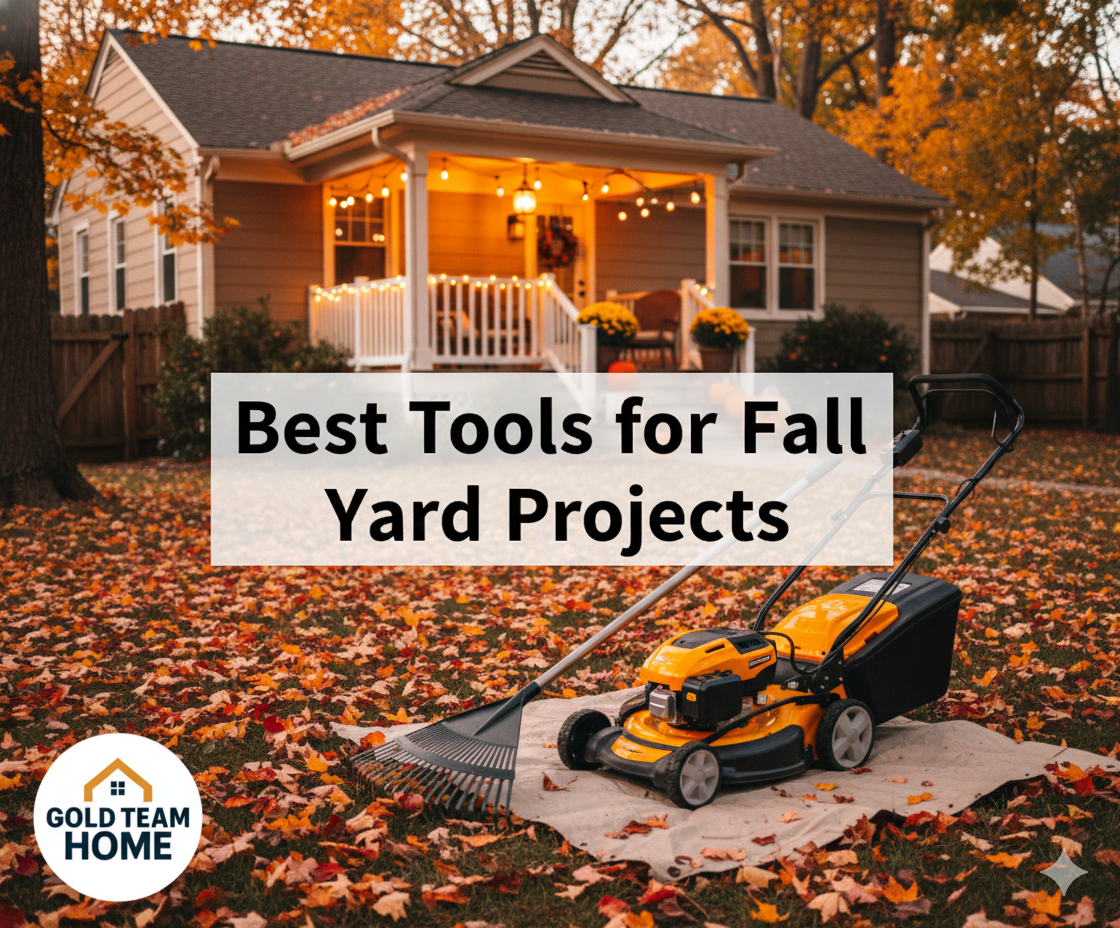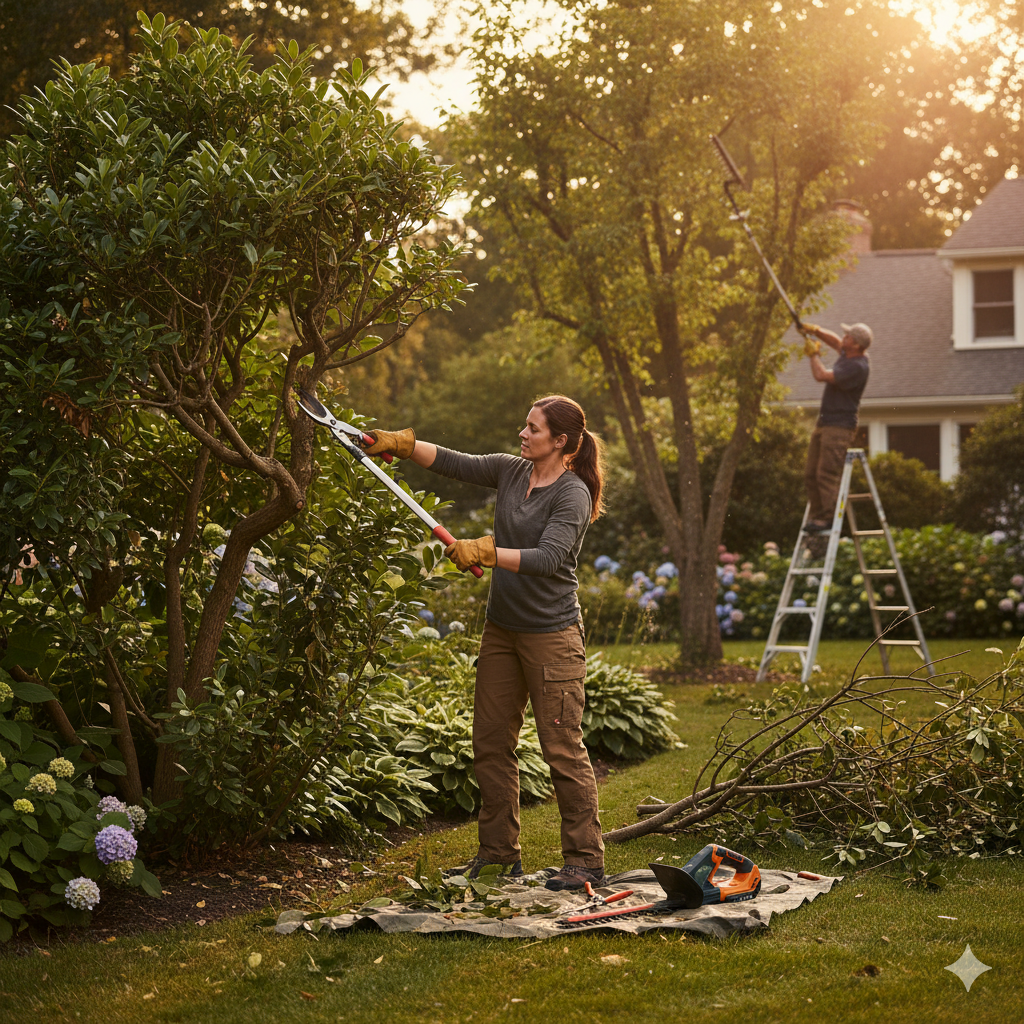New! DIY Project Planner. Plan smarter, skip the spreadsheets. Start Your Free Trial Today →

When the leaves start to turn and the evenings get noticeably cooler, your yard quietly signals that it’s time for fall maintenance. It’s tempting to grab a rake and hope for the best, but using the right tools makes the work faster, safer, and more sustainable. In this guide you’ll learn which tools professional landscapers and experienced DIYers rely on to handle fall yard projects. From clearing leaves and aerating soil to trimming shrubs and adding a bit of cozy lighting. Each section explains why a tool matters, how to use it safely, and when it’s worth investing in a specialty attachment versus borrowing or renting. Throughout the article you’ll find internal links to our other fall-prep guides, including the Essential Fall Home Maintenance Checklist, DIY Fall Décor Projects That Don’t Look Tacky and How to Winterize Your Home in Fall. For any larger projects, our DIY Project Planner helps you map out tasks, track costs and manage your time.

When you picture fall yard work, you probably imagine a rake. Today’s leaf‑removal tools are lighter and smarter than the clunky metal rakes of the past. Ergonomic leaf rakes now feature adjustable handles, lightweight aluminum or fiberglass construction, flexible tines and cushioned grips. The combination of a longer handle and springy tines allows you to clear leaves efficiently while reducing strain on your wrists and back. These rakes excel in small and medium yards and around delicate plantings where blowers can’t reach.
For larger piles, consider leaf scoops — giant “bear claws” for your hands. They look silly at first, but they let you grab huge amounts of leaves in one pass and dramatically speed up the bagging process. Because scoops reduce the number of times you have to bend over, they protect your lower back and knees. Paired with a durable tarp, you can rake or blow leaves onto the tarp and then drag hundreds of pounds of debris to a compost pile or curb. Making simple handles out of dowels transforms a basic tarp into an efficient leaf‑sled.
If you bag your leaves for pickup, a leaf chute can be a game‑changer. These funnel‑shaped devices hold bags open and prevent the leaf “explosion” that happens when you try to stuff leaves into a flimsy paper sacklawnlove.com. They fit standard lawn and leaf bags, adjust to a comfortable height, and are particularly useful if you often work alone or on windy dayslawnlove.com.

Manual tools are great for detail work, but they can’t match the efficiency of power equipment on large properties. Leaf blowers range from corded electric models to battery‑powered units and gas‑powered backpack blowers. Handheld electric models are ideal for yards under half an acre; cordless, battery‑powered blowers provide mobility for medium yards; and gas backpack blowers deliver the airflow needed to move leaves on large properties. Blowers aren’t just for leaves — they can also clear grass clippings off patios and remove light snow from sidewalks.
Another multifunctional tool is the leaf vacuum, which combines a blower, vacuum and mulching system in one machine. These units suck up leaves and shred them into compostable material, compressing the volume by about 10:1. Leaf vacuums excel in yards with mixed debris — leaves, twigs, pine needles and seeds — and are a good choice if you like to compost. For truly large jobs, walk‑behind vacuums and tow‑behind sweepers attach to riding mowers and collect leaves as you drive. They’re more expensive but save immense time on multi‑acre properties.
Perhaps the most sustainable option is a mulching mower with specialized blades or a mulching kit. These mowers chop leaves into tiny pieces and return them to your lawn as natural fertilizer. University of Connecticut turf experts note that during each mulching pass you should ensure no more than about 20 % of the lawn is covered by leaf pieces so the grass still receives sunlight. Mulching often, instead of waiting until leaves form a thick carpet, produces the best results. Using a mulching mower also eliminates bagging and reduces the amount of yard waste your municipality has to process.
Pro Tip: To make leaf management easier, combine tools. Use a blower to corral leaves into piles, switch to scoops to load them onto a tarp or into bags, and finish with a mulching mower on the lawn itself. This layered approach saves time and keeps your yard healthier.

Fall is the ideal time to give your lawn a “spa day.” Over summer, foot traffic and drought compact the soil and create a thick thatch layer that blocks water and nutrients. Aerating loosens the soil and creates channels for air, water and fertilizer to reach the roots. According to lawn‑care experts, aeration alleviates soil compaction, improves drainage and helps grass grow thicker. It’s performed by perforating the lawn with small holes to increase oxygen and nutrient flow to the root zone. When roots get breathing room, your lawn becomes more resilient to heat and drought stress in the coming year.
There are two primary aeration methods: core (plug) aeration and spike aeration. Core aeration uses hollow tines to remove plugs of soil and thatch, leaving behind small cylinders on the surface. These plugs break down over time, acting as a natural top dressing. Core aeration is the method of choice for lawns with moderate to severe compaction because it relieves the physical limitations of dense soil. Spike aeration, on the other hand, pushes solid spikes into the ground. It’s an inexpensive DIY fix for mildly compacted lawns but offers shorter‑term benefits.
After aerating, overseed thin or patchy areas to establish new grass before winter. Fall’s cooler temperatures and higher rainfall provide an ideal environment for seed germination. Use a broadcast spreader to apply seed evenly, lightly rake it in, and water gently for the next two weeks. This step pairs well with dethatching, which removes the dense layer of dead stems and roots near the soil surface. Power dethatchers (vertical mowers) can be rented, while manual dethatching rakes are inexpensive for small lawns. Follow aeration with a balanced fertilizer to encourage root growth; use our Essential Fall Home Maintenance Checklist for guidance on soil testing and nutrient selection.

It’s tempting to use fall’s mild weather to trim back unruly trees and shrubs, but heavy pruning in late summer or fall can stimulate new growth that may be injured by winter cold. The Iowa State University extension notes that most deciduous trees should be pruned during the late dormant season (February through March.) Pruning when trees are leafless allows you to see the branch structure clearly and ensures the wounds begin healing as spring growth starts. Deciduous trees can tolerate occasional pruning at other times — such as to remove storm damage — but experts recommend avoiding pruning in spring when trees are leafing out and in fall when they are dropping leaves. Evergreen trees require little pruning; dead or damaged branches can be removed any time, while significant cuts should be made in late winter.
So what does this mean for fall yard work? Use autumn for light shaping and clean‑up only. Remove dead or diseased branches before winter storms can topple them, but save major cuts for late winter. Invest in a good pair of bypass hand pruners and long‑handled loppers. Bypass pruners (with two curved blades) make clean cuts that heal quickly. Loppers extend your reach for branches up to 1½ inches thick. For higher limbs, a pole saw or pole pruner lets you cut safely from the ground — look for models with adjustable lengths and a pruning saw or bypass blade.
Tip: Disinfect pruning blades with a 10 % bleach solution or isopropyl alcohol when moving between plants to prevent disease transmission. Always wear eye protection and gloves.
If you have formal hedges (privet, boxwood, yew), you may need to shear them twice a year to maintain shape. Electric hedge trimmers make quick work of long hedges; choose a model with a rotating rear handle to reduce wrist fatigue. However, avoid heavy shearing after mid‑summer because it encourages tender growth that may not harden off before winter.
In addition to leaves and branches, your yard likely accumulates spent annuals, vegetable plants and dead perennials. Garden forks and spading shovels help you turn over vegetable beds and incorporate compost or shredded leaves into the soil. A wheelbarrow or utility cart is invaluable for hauling debris — some models attach to riding mowers, holding up to 25 cubic feet. For tight spaces, consider a stand‑up weeder to remove perennial weeds without bending, and use leaf scoops to pick up the mess.
Mulching garden beds in fall protects plant roots and suppresses winter weeds. Spread a 2‑ to 3‑inch layer of shredded bark, pine needles or chopped leaves around perennials and shrubs, keeping mulch a few inches away from stems. Using the mulched material created by your leaf vacuum or mulching mower saves money and closes the nutrient loop.
If your property borders open fields or forest, fall is the time to inspect for invasive vines or saplings. A brush cutter attachment for your string trimmer can cut through tough stems, and a bow saw handles thicker branches. Wear long sleeves and safety glasses when using any cutting tool.

Shorter days mean you’ll likely spend more time outside after dark, whether grilling, entertaining on the patio or simply taking out the recycling. Proper lighting ensures safety and extends the enjoyment of your outdoor spaces. Here are some recommendations:
When installing any electrical lighting, follow manufacturer instructions and local codes. Hire a licensed electrician if you’re unsure about wiring a transformer or connecting lights to an existing circuit.
Quality tools are an investment. Look for features such as cushioned grips, adjustable handles, and rust‑resistant materials. For power tools, consider battery platforms that work across multiple tools — this reduces the number of chargers and batteries you need. Store hand tools in a dry area and clean off soil and sap after each use. Sharpen pruners, loppers and mower blades regularly; dull blades tear plant tissue and make plants more susceptible to disease. At the end of the season, empty fuel from gas‑powered equipment or add stabilizer, and charge batteries to about 40 % before storing them over winter.
When deciding between buying or renting equipment like aerators and power dethatchers, think about how often you’ll use the tool and your storage space. Renting is cost‑effective for large, infrequent tasks; buying makes sense if you maintain a large property or share equipment with neighbors. Tool libraries are another option — some communities let you borrow aerators or specialty tools for a small fee.
Fall yard projects aren’t just about aesthetics — they set the stage for a healthier lawn and garden next spring. By investing in a few thoughtfully chosen tools and understanding when and how to use them, you can save hours of work and avoid costly mistakes. Remember to combine manual tools like ergonomic rakes and leaf scoops for finesse, power equipment for efficiency, and sustainable practices like mulching leaves back into the lawn. Aerate and overseed lawns before winter, prune judiciously at the right time, and don’t forget to light your pathways for safety.
For more detailed guides on prepping your home for the cooler months, explore our related posts:
If you’re ready to tackle a bigger project, use our DIY Project Planner to organize tasks, track your budget and stay on schedule. With the right tools and a bit of planning, your yard will be ready for winter and primed to thrive when spring arrives.